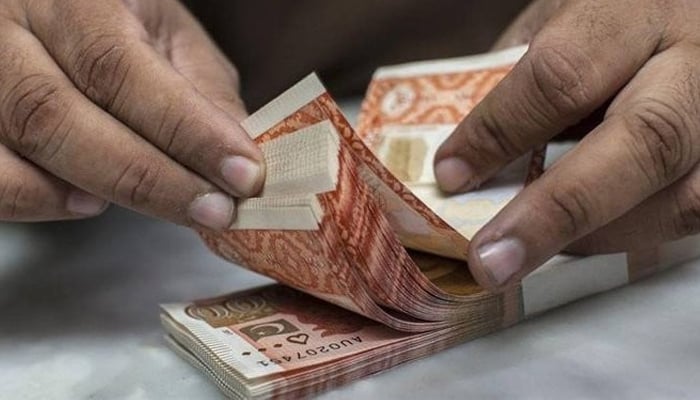Since 2011, in nominal terms, Pakistan’s external debt has near doubled, and domestic debt has increased by six-fold. In FY-2024  A person Counting Pak Currency. — AFP/File
A person Counting Pak Currency. — AFP/File
ISLAMABAD: Pakistan’s total public debt and liabilities are becoming unsustainable. The country’s external debt doubled while domestic debt has increased by six-fold since 2011.
“Pakistan’s debt is a formidable, existential and pertinent challenge that requires immediate and strategic interventions. Debt repayments are at a historic high, deprioritizing the needs of a growing population, such as social protection, education, health, and crucially, climate change.”
This was stated in a detailed report think-tank Tabadlab released here on Sunday. Detailed in Tabadlab’s seminal analysis, “A Raging Fire,” the gravity of this crisis is laid bare, revealing the depth and breadth of the problem, the quantum of financial resources lacking and the path forward with or without transformational structural changes.
By dissecting key financial indicators, drawing comparisons with global standards and showcasing multi-scenario projections “A Raging Fire” serves as a critical blueprint for navigating Pakistan’s debt dilemma.
Providing comprehensive solutions in a dedicated section, the analysis ends with crucial reforms needed to extricate Pakistan from this perennial financial spiral and put it on a path to economic recovery, eventually leading to prosperity.
Since 2011, in nominal terms, Pakistan’s external debt has near doubled, and domestic debt has increased by six-fold. In FY-2024, Pakistan will need to pay back an estimated $49.5 billion in debt maturities (30% of which is interest, and none of which is a bilateral or IMF loan). Debt accumulation has been overwhelmingly used to continue fostering a consumption-focused, import-addicted economy, without investment in productive sectors or industry. Pakistan’s debt profile is alarming and its borrowing and spending habits are unsustainable. Increasing demands of a growing population require more money for social protection, health, education, and climate change related disasters, adaptation strategies, and the green transition. Pakistan’s climate and debt vulnerability exacerbate one another, but there is an opportunity to synergize and mitigate both existential crises at the same time.
Pakistan’s boom and bust cycles are shortening rapidly, disallowing long periods of sustained growth (fueled by consumption, rather than industrialization or productive sector enhancement). Sustained Current Account Deficit with a small exception, Pakistan’s inflows of foreign currency have always been outpaced by its outflows. It is unable to increase remittances, improve the export sector, or restrict imports so that growth and industry expansion are not negatively affected.
This results in mostly external borrowing. Perennial Fiscal Deficit Domestically, Pakistan has not been able to reconcile its expenses with its revenues, resulting in a fiscal deficit for the national exchequer. This results in mostly domestic borrowing, which has the added disadvantage of crowding out the private sector. All of this implies that Pakistan needs to borrow to meet most of its needs, including climate change and resilience efforts.
The quantum of debt Pakistan requires is growing faster than the net output of the economy (GDP). This means that the economy’s ability to grow or increase output is constrained.
This is unsustainable. It demands transformational change. Unless there are sweeping reforms and dramatic changes to the status quo, Pakistan will continue to sink deeper, headed towards an inevitable default, which would be the start of the spiral.
Climate needs inevitably exacerbate Pakistan’s debt profile unless climate swaps are leveraged to mitigate both problems.












